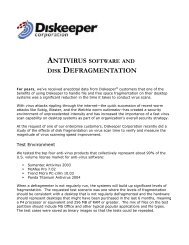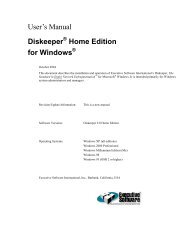Diskeeper 10 User's Manual
Diskeeper 10 User's Manual
Diskeeper 10 User's Manual
You also want an ePaper? Increase the reach of your titles
YUMPU automatically turns print PDFs into web optimized ePapers that Google loves.
26 <strong>Diskeeper</strong> Operation<br />
[Excess<br />
Allocation]<br />
Analysis and<br />
Defragmentation<br />
NTFS Only<br />
With the NTFS file system, a file can be allocated<br />
more clusters than its data is actually using. On<br />
Windows NT 4 and Windows 2000, only the data<br />
portion of the allocation can be defragmented. As<br />
a result, even though a file is reported as<br />
fragmented, the data portion of the file may in fact<br />
be contiguous. This most commonly occurs with<br />
registry files and (under Windows 2000) files that<br />
have been decompressed. In some cases, files of<br />
this type can be defragmented after a system<br />
restart<br />
[Partially<br />
Defragmente<br />
d]<br />
Defragmentation<br />
Only<br />
NTFS and<br />
FAT<br />
This file has been partially defragmented. Its<br />
fragments have been reduced in number, but the<br />
file is not yet contiguous.<br />
[Insufficient<br />
Contiguous<br />
Free Space]<br />
Terabyte<br />
Volume Engine<br />
Defragmentation<br />
Only<br />
NTFS Only<br />
There was insufficient free space to defragment<br />
the file.<br />
[Move<br />
refused by<br />
OS]<br />
Terabyte<br />
Volume Engine<br />
Defragmentation<br />
Only<br />
NTFS Only<br />
Although <strong>Diskeeper</strong> requested the file move, the<br />
operating system denied the request. This can<br />
happen when free space previously located by<br />
<strong>Diskeeper</strong> is overwritten by other file activity, or if<br />
a file is deleted or extended during the<br />
defragmentation attempt.<br />
Job Log Tab<br />
The Job Log tab shows information about all the defragmentation jobs you have run on each volume. As you<br />
highlight each volume in the Computer pane, the information displayed in the Job Log changes to reflect the<br />
selected volume. The Job Log information includes:<br />
• Job Type⎯This column shows the type of defragmentation job run (Primary, Secondary, I-FAAST, or<br />
<strong>Manual</strong> defragmentation)<br />
• Date⎯This column shows the date each job was run.<br />
• Volume⎯This column shows volume label for the selected volume.<br />
• Times Run⎯This column shows the number of times each particular job type has been run on the selected<br />
volume.<br />
• Fragments Eliminated⎯This column shows a cumulative total of the number of fragments eliminated for<br />
each defragmentation job type.<br />
The Job Log saves up to six months worth of data. New data afterwards will overwrite the oldest data in the Job<br />
Log.<br />
You can also save the Job Log (as an HTML file) or print it by using the respective buttons on the Job Log tab.






